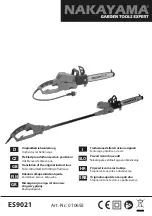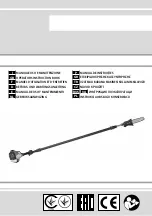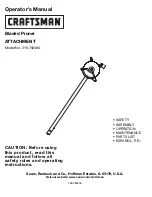
www.scheppach.com
+(49)-08223-4002-99
+(49)-08223-4002-58
18 І 56
•
The laser may not be replaced with a different type
of laser.
•
Repairs of the laser may only be carried out by the
laser manufacturer or an authorised representative.
Safety instructions for handling batteries
1
Always make sure that the batteries are inserted
with the correct polarity (+ and –), as indicated on
the battery.
2
Do not short-circuit batteries.
3
Do not charge non-rechargeable batteries.
4
Do not overcharge batteries!
5
Do not mix old and new batteries or batteries of
different types or manufacturers! Replace an entire
set of batteries at the same time.
6
Immediately remove used batteries from the device
and dispose of them properly!
7
Do not allow batteries to heat up!
8
Do not weld or solder directly on batteries!
9
Do not dismantle batteries!
10
Do not allow batteries to deform!
11
Do not throw batteries into fire!
12
Keep batteries out of the reach of children.
13
Do not allow children to replace batteries without
supervision!
14
Do not keep batteries near fire, ovens or other
sources of heat. Do not use batteries in direct sun-
light or store them in vehicles in hot weather.
15
Keep unused batteries in the original packaging and
keep them away from metal objects. Do not mix
unpacked batteries or toss them together! This can
lead to a short-circuit of the battery and thus dam-
age, burns or even the risk of fire.
16
Remove batteries from the equipment when it will
not be used for an extended period of time, unless
it is for emergencies!
17
NEVER handle batteries that have leaked without
appropriate protection. If the leaked fluid comes into
contact with your skin, the skin in this area should be
rinsed off under running water immediately. Always
prevent the fluid from coming into contact with the
eyes and mouth. In the event of contact, please seek
immediate medical attention.
18
Clean the battery contacts and corresponding con-
tacts in the device prior to inserting the batteries
10. Remaining hazards
The machine has been built using modern technol-
ogy in accor dance with recognized safety rules.
Some remaining hazards, how ever, may still exist.
• The use of incorrect or damaged mains cables can
lead to injuries caused by electricity.
• Even when all safety measures are taken, some re-
maining hazards which are not yet evident may still
be present.
• Remaining hazards can be minimized by following the
instructions in „Safety Precautions“, „Proper Use“ and
in the entire operating manual.
• Do not force the machine unnecessarily: excessive
cutt ing pressure may lead to rapid deterioration of the
blade and a decrease in performance in terms of finish
and cutting precision.
8.
Safety instructions for inserted circular
saw use
INSTRUCTIONS FOR ALL SAWS
• Make sure that the dust catching mechanism is cor-
rectly installed, as is described in this manual.
• Wear breathing protection.
• Only those saw blades recommended in the manual
should be used.
• Always wear ear protection.
• Replace the saw blades as described in this manual.
•
The maximum cut depth is 28,5 mm.
If the electrical cable of this tool is damaged it must be
replaced by the manufacturer or the customer service
department or a similarly qualified specialist in order to
avoid dangers.
Further Special safety Instructions for Circular Saws
Only use the recommended saw blades which corres-
pond to EN 847-1.
Do not use any saw blades which do not correspond
to the characteristics described in these operating ins-
tructions. Saw blades may not be brought to a stop by
pressure on the machine from the side.
Make sure that the saw blade is tightly assembled and
turns in the correct direction.
9.
Special Safety Instructions
Safety instructions for circular saws
- Hold the equipment on the insulated handles, when
you undertake work in which the tool being used could
come into contact with hidden electrical wires, or its own
cable. Contact with a live power source can electrify the
metal parts of the tool and lead to an electrical shock.
Attention: Laser radiation
Do not stare into the beam
Class 2 laser
0
Protect yourself and you environment from acci-
dents using suitable precautionary measures!
•
Do not look directly into the laser beam with unpro-
tected eyes.
•
Never look into the path of the beam.
•
Never point the laser beam towards reflecting sur
-
faces and persons or animals. Even a laser beam
with a low output can cause damage to the eyes.
•
Caution - methods other than those specified here
can result in dangerous radiation exposure.
•
Never open the laser module. Unexpected exposure
to the beam can occur.
•
If the mitre saw is not used for an extended period
of time, the batteries should be removed.
GB
















































